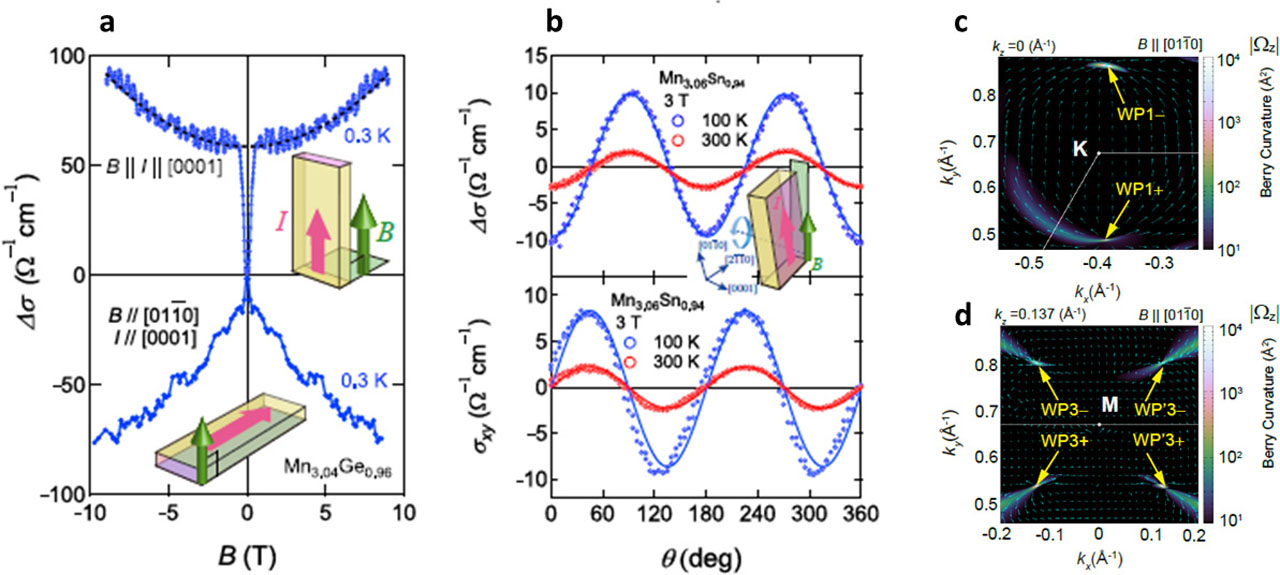Weyl-Fermion-Induced Anomalous Transport in the Chiral Antiferromagnets Mn3X, (X = Sn, Ge)
Nakatsuji Group
The blooming field of spintronics has bridged astonishingly complex antiferromagnetic structures to the realm of energy-efficient memory technologies. However, a significant obstacle to overcome is the tiny response of the antiferromagnetic structure to external magnetic fields [1]. The recent discoveries of large room-temperature anomalous transport effects in antiferromagnets Mn3X (X = Sn, Ge) [2,3] signifies an experimental breakthrough in this direction, bringing the study on strongly correlated topological phases to the main stage of basic science and technological innovation. These anomalous transport properties are considered fingerprints of Weyl fermions in the momentum-space band structure [4]. Therefore, understanding the role of magnetic Weyl fermions in driving the transport properties of chiral antiferromagnets is all the more important for making real-life applications with topological states of matter.
In this work, we establish Weyl fermions as the origin of the large anomalous Hall and Nernst effects in Mn3X systems by combining our previous reports with a new, comprehensive set of transport measurements and theoretical analysis of high-quality Mn3Sn and Mn3Ge single crystals [5]. In particular, Mn3Ge provide an ideal experimental platform for identifying transport signatures stemming from Weyl fermions; in this compound, the inverse triangular covers a wide temperature range down to at least 0.3 K, approximately one-thousandth of the Néel temperature. This feature allows a clear-cut detection of the Weyl-fermion-induced transport anomalies at sufficiently low temperatures, where spin fluctuations are essentially suppressed.
The fingerprint of Weyl points in magnetotransport is known as the chiral anomaly. With a magnetic field, the Weyl crossings are quantized into Landau levels (LLs), and the lowest LL are divided into left- and right-movers of opposite chirality. These two groups do not mix, leading to separate number conservation of the three-dimensional left- and right-handed Weyl fermions. Once an electric field parallel to the magnetic field is applied, the conservation of chirality no longer holds due to mixing the left-and-right movers. In such a case, charge pumping between the Weyl nodes of opposite chirality generates the positive longitudinal magnetoconductivity (LMC) or the negative magnetoresistivity (LMR) only when the electric current and magnetic field are parallel to each other. This strongly anisotropic behavior of LMC provides transport evidence for Weyl fermions.
Our findings of magnetotransport signatures specific to chiral anomalies in Mn3Ge and planar Hall effect in Mn3Sn provide concrete evidence for the presence of Weyl fermions in both materials. Figure 1a shows the field dependence of the magnetoconductivity observed in Mn3Ge at 0.3 K. For applied fields B > 2T, the magnetoconductivity becomes positive for the parallel configuration and is nearly quadratic in magnetic field. The B2 dependence of the positive LMC is likely a result of strongly titled type-II Weyl cones with the applied magnetic field perpendicular to the tilt axis. We further verified that the angular dependence of the magnetoconductivity and the planar Hall signal observed in Mn3Sn agree well with the theoretical forms for the chiral anomaly (Fig. 1b), another transport evidence for magnetic Weyl fermions.

Fig. 1. (a) The magnetoconductivity as a function of the magnetic field B for the parallel and perpendicular configurations with the current I || [0001] measured at 0.3 K in Mn3Ge. The dashed line is a fit to the quadratic magnetic field dependence. (b) Angle dependence of the longitudinal magnetoconductivity (top) and the planar Hall effect (PHE) (bottom) in Mn3.06Sn0.94 obtained at 300 and 100 K under B = 3 T. (c, d) Contour plots of the calculated Berry-curvature spectrum |Ωz| in the kx–ky-plane under B || [01-10] at kz = 0 (Å−1) (c) and at kz = 0.137 (Å−1) (d). The arrows indicate the Berry curvature induced by the pairs of Weyl points WP1 and WP3 (WP'3) near the Fermi level.
Moreover, we compare our results on the anomalous Hall and Nernst effects with the first-principles calculations that consider the substantial bandwidth renormalization and quasiparticle damping due to the strong electronic correlation in Mn3X systems (Fig. 1c, d). The calculated transverse thermoelectric coefficients well reproduce the overall temperature dependence of the experimental data, suggesting that the large Berry curvature stemming from the Weyl nodes leads to significantly enhanced AHE and ANE in the absence of net magnetization.
Strongly correlated topological states have become a central focus for quantum materials research, and Mn3X (X = Sn, Ge) is widely considered a textbook example of this kind. Our findings provide concrete evidence for the presence of Weyl fermions in both materials, which may trigger further exploration of their rich physics and useful properties emerging from the interplay between magnetism and band topology.
References
- [1] T. Jungwirth et al., Nat. Nanotechnol. 11, 231 (2016).
- [2] S. Nakatsuji et al., Nature 527, 212 (2015).
- [3] M. Ikhlas, T. Tomita et al., Nat. Phys. 13, 1085 (2017).
- [4] K. Kuroda et al., Nat. Mater. 16, 1090 (2017).
- [5] T. Chen, T. Tomita, S. Minami, M. Fu et al., Nat. Comm. 12, 572 (2021).
